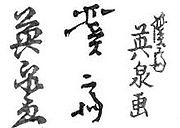
Keisai Eisen
Encyclopedia


Japanese people
The are an ethnic group originating in the Japanese archipelago and are the predominant ethnic group of Japan. Worldwide, approximately 130 million people are of Japanese descent; of these, approximately 127 million are residents of Japan. People of Japanese ancestry who live in other countries...
ukiyo-e
Ukiyo-e
' is a genre of Japanese woodblock prints and paintings produced between the 17th and the 20th centuries, featuring motifs of landscapes, tales from history, the theatre, and pleasure quarters...
artist who specialised in bijinga
Bijinga
Bijinga , is a generic term for pictures of beautiful women in Japanese art, especially in woodblock printing of the ukiyo-e genre, which predate photography...
(pictures of beautiful women). His best works, including his ōkubi-e
Okubi-e
An ōkubi-e is a portrait print or painting showing only the head or the head and upper torso. Katsukawa Shunkō I is generally credited with producing the first ōkubi-e. He, along with Katsukawa Shunshō, only designed ōkubi-e of kabuki actors. In the early 1780s, Kitagawa Utamaro designed the...
("large head pictures"), are considered to be masterpieces of the "decadent" Bunsei
Bunsei
was a after Bunka and before Tenpō. This period spanned the years from April 1818 through December 1830. The reigning emperor was .-Change of era:...
Era (1818–1830). He was also known as Ikeda Eisen, and wrote under the name of Ippitsuan.
Biography
Eisen was born in EdoEdo
, also romanized as Yedo or Yeddo, is the former name of the Japanese capital Tokyo, and was the seat of power for the Tokugawa shogunate which ruled Japan from 1603 to 1868...
into the Ikeda family, the son of a noted calligrapher
East Asian calligraphy
East Asian calligraphy is a form of calligraphy widely practised and revered in the Sinosphere. This most often includes China, Japan, Korea, and Vietnam. The East Asian calligraphic tradition originated and developed from China. There is a general standardization of the various styles of...
. He was apprenticed to Kanō Hakkeisai, from whom he took the name Keisai, and after the death of his father he studied under Kikugawa Eizan. His initial works reflected the influence of his mentor, but he soon developed his own style.
He produced a number of surimono
Surimono
are a genre of Japanese woodblock print. They were privately commissioned for special occasions such as the New Year. Surimono literally means "printed thing". Being produced in small numbers for a mostly educated audience of literati, surimono were often more experimental in subject matter and...
(prints that were privately issued), erotic prints
Shunga
' is a Japanese term for erotic art. Most shunga are a type of ukiyo-e, usually executed in woodblock print format. While rare, there are extant erotic painted handscrolls which predate the Ukiyo-e movement...
, and landscapes, including The Sixty-nine Stations of the Kiso Kaidō
The Sixty-nine Stations of the Kiso Kaido
The or Sixty-nine Stations of the Kiso Road, is a series of ukiyo-e works created by Utagawa Hiroshige and Keisai Eisen. There are 71 total prints in the series...
, which he started and which was completed by Hiroshige
Hiroshige
was a Japanese ukiyo-e artist, and one of the last great artists in that tradition. He was also referred to as Andō Hiroshige and by the art name of Ichiyūsai Hiroshige ....
. However, his most famous works are the bijin-e (pictures of beautiful women) which portrayed the subjects as more worldly than those depicted by earlier artists, replacing their grace and elegance with a less studied sensuality. He produced many portraits and full-length studies depicting the fashions of the time.
In addition to producing a prolific number of prints, he was a writer, producing biographies of the Forty-seven Ronin
Forty-seven Ronin
The revenge of the , also known as the Forty-seven Samurai, the Akō vendetta, or the took place in Japan at the start of the 18th century...
and several books, including a continuation of the Ukiyo-e Ruiko (History of Prints of the Floating World), a book which documented the lives of the ukiyo-e artists. His supplement is known as "Notes of a Nameless Old Man." He describes himself as a dissolute hard-drinker and claims to have been the owner of a brothel in Nezu in the 1830s which had burned down.

